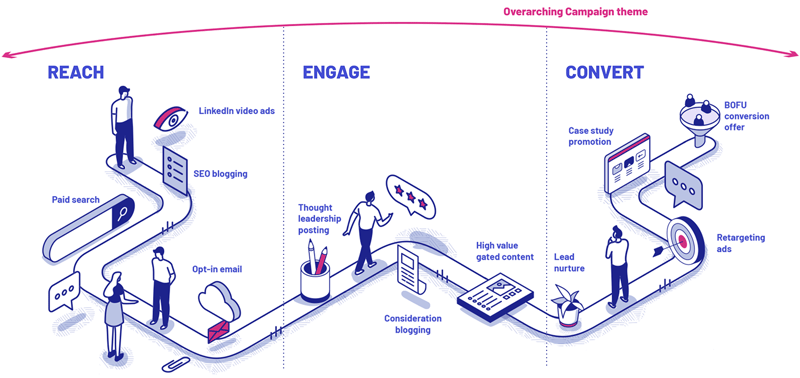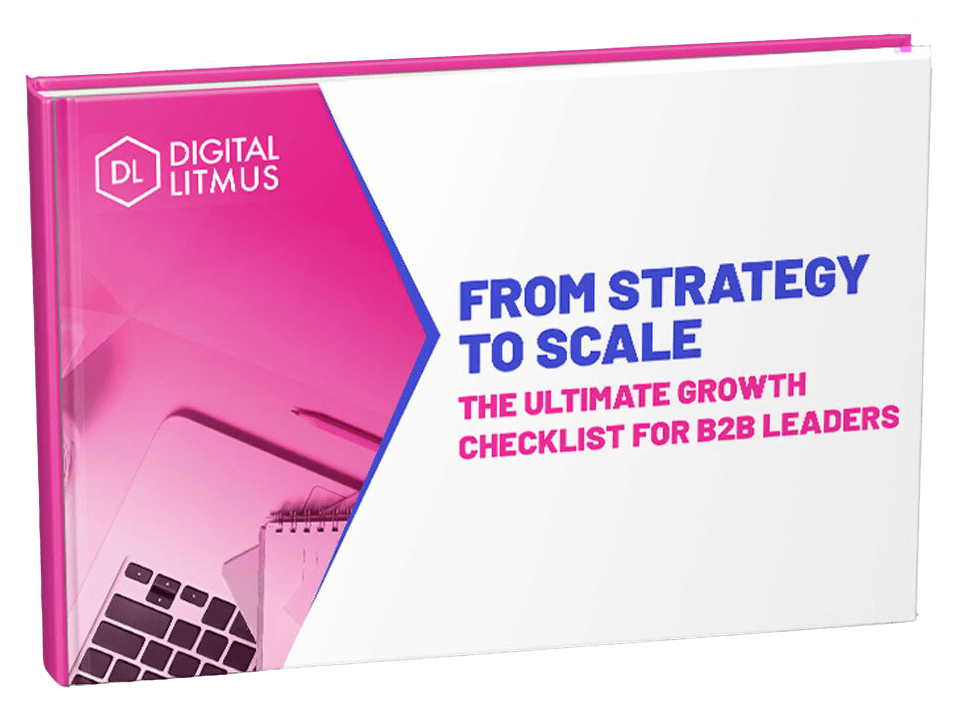In the rapidly evolving SaaS landscape, where competition is fierce and attention spans are fleeting, success hinges on having a rock-solid foundation. Simply following the usual practices of inbound marketing won't cut it anymore. To truly generate leads and drive business growth, it's time to think beyond the norm and embrace a mix of strategic marketing tactics and savvy tech tools.
As a SaaS business, your success is largely dependent on your ability to attract new and qualified leads through various channels where your ideal customer profiles (ICPs) consume content and seek value. There is also a need to continuously adopt new technologies and approaches that complement the larger inbound ecosystem.
We understand that it can be overwhelming to think about it all. That's why we've created the ultimate SaaS Inbound Marketing Checklist, featuring ten must-do strategies to supercharge your lead generation and marketing efforts.
Shortcuts
Revisit Your Foundations - Personas, Value Prop, Data, Tech
Build a Content Strategy Focusing on Buyer Pain Points
Capture Demand With BOFU SEO Content
Use Generative AI In Your Content Production
Develop Super High-Quality Content
Rapidly Reboot Your Brand With a ‘Brand Sprint’
Don’t Be Boring - Develop Points of View and Messaging Pillars
Run Integrated, Multi-Channel Campaigns
Build Your Website Backlog - Your Plan for Growth
Remove Friction in the Buyer Journey With Automation
Revisit Your Foundations - Personas, Value Prop, Data, Tech

Successful SaaS inbound marketing require a strong foundation built upon key elements such as buyer personas, a compelling value proposition, reliable data, and the right technology. Start your inbound marketing reboot by returning to the following fundamentals.
Refine Your Buyer Personas
Buyer personas are semi-fictional representations of your ideal customers, providing insights into their needs, pain points, and behaviours.
Revisit and update your personas regularly to ensure they reflect evolving market dynamics and customer preferences. Analyse customer feedback, conduct surveys, and leverage customer data to refine your personas, enabling you to tailor your marketing messages more effectively.
Everything starts with the customer - that’s why building out a useful and structured model of the people you sell to will pay huge dividends across all of your inbound marketing.
Evolve Your Value Proposition
Your value proposition should clearly articulate the unique benefits and value your SaaS solution offers to customers.
Redefine your value proposition and evaluate its relevance in the current market landscape. Identify any gaps or areas for improvement, and refine your messaging to align with the pain points and desired outcomes of your target audience.
Once you’ve evolved your value proposition, make sure you test it with your prospects and customers - that’s the only way to know for sure that you’ve hit the mark. Rapid testing tools like Wynter can help you here.
Build Your Target Market Data in Your CRM
Data plays a crucial role in driving informed decision-making and targeted marketing campaigns.
You can mine new prospect data or augment existing records with tools like Zoominfo, Beauhurst and Cognism. These tools can all be used to expand your database and provide insights on your target accounts and contacts. Once you have a solid CRM, explore ways to segment it and use it for campaigns and personalisation.
Create Robust Technology Foundations
Disparate tech tools can make operations and reporting much more complex, and in some cases, almost impossible. Never-mind the extra costs associated with multiple software licences. The benefit of connecting your tech stack under the umbrella of a CRM system, such as HubSpot, is that it allows you to streamline processes, automate manual tasks and reduce not only operational friction but the need for redundant or inefficient software.
Build a Content Strategy Focusing on Buyer Pain Points

By developing content that directly addresses the pain points and challenges faced by your buyers, you can position your brand as a trusted resource and drive meaningful connections.
Map Content to the Buyer Journey
Consider the different stages of the buyer's journey - awareness, consideration, and decision. Develop content that aligns with each stage, catering to the specific needs and concerns of your audience depending on where they are in their journey.
In the awareness stage, focus on educational and informative content that addresses broader needs and topics - help them identify a key problem that your business solves.
In the consideration stage, offer in-depth guides, and comparisons that highlight the value of your solution.
Finally, in the decision stage, provide content that builds trust, such as case studies, testimonials and free trials.
Diversify Content Formats
Vary the formats of your content to cater to different audience preferences. Besides blog posts and articles, explore other formats like videos, gated guides, webinars, and reports.
This diversification allows you to present information in engaging and easily digestible ways, capturing the attention of your target audience.
Personalisation and Customisation
Tailor your content to specific buyer personas needs. Craft messaging that speaks directly to their challenges and offers tailored solutions.
Use personalisation techniques to address your audience by name and segment your email campaigns based on their interests and behaviours. This level of personalisation enhances the relevance and impact of your content.
Consistency and Distribution
Develop a consistent content publishing schedule to keep your audience engaged and build brand credibility. Leverage various distribution channels, such as your website, social media platforms, blogging opportunities, and email newsletters, to reach a wider audience.
Monitor the performance of your content using analytics tools and refine your strategy based on the insights gained.
By building a content strategy that focuses on addressing buyer pain points, you can position your SaaS business as a valuable resource and trusted authority.
Capture Demand With BOFU SEO Content

In the realm of SaaS inbound marketing, capturing (existing) demand and attracting qualified leads is a top priority. To achieve this, focusing on bottom-of-the-funnel (BOFU) SEO content is essential.
By optimising your content for search engines and targeting keywords that align with your offering, you can position your brand in front of prospects who are actively seeking solutions.
Prioritise BOFU SEO Content
Bottom-of-the-funnel (BOFU) SEO content is designed to target keywords that are highly relevant to your SaaS solution and appeal to prospects who are in the later stages of the buyer journey.
These keywords often include terms such as "best," "top," "comparison," and "reviews," indicating that the searcher is actively and intentionally evaluating different options and looking for the best fit for their needs. Other high-intent keywords to look out for are those that are a close match for your product category e.g. “attribution platform” or “analytics software” etc.
Craft content that addresses the specific needs and concerns of prospects in the later stages of the buyer journey. Develop comparison guides, product reviews, case studies, and in-depth articles that highlight the unique value and benefits of your SaaS solution. Provide actionable insights and data-driven information to support decision-making and position your brand as a trustworthy authority.
Keyword Research and Analysis
Perform thorough keyword research to identify high-intent keywords that align with your offering. Use keyword research tools, such as SEMRush and Moz, to discover relevant keywords with reasonable search volumes and manageable competition. Consider long-tail keywords that specifically address pain points and indicate buyer intent.
You can also analyse competitor strategies to gain insights into keywords they are targeting successfully, and identify keyword gaps that you can leverage to easily sweep up in ranking opportunities.
On-Page SEO Optimisation
Optimise your BOFU content for search engines to improve visibility and attract qualified traffic. Ensure that your target keywords are strategically placed in the page title, meta description, headings, and throughout the content. Pay attention to the readability and user experience of your content by incorporating relevant images, bullet points, and subheadings.
By focusing on BOFU SEO content, you can capture demand from prospects who are actively evaluating solutions, increasing the likelihood of converting them into customers.
Use Generative AI In Your Content Production

Staying ahead of the curve is essential. One innovative approach gaining traction is the incorporation of generative artificial intelligence (AI) into content production. By leveraging AI-powered tools and technologies, you can streamline your content creation process, enhance creativity, and drive more impactful marketing campaigns.
Understanding Generative AI in Content Production
Generative AI refers to the use of machine learning algorithms to generate creative and original content. AI tools such as ChatGPT, can assist in various aspects of content production, including ideation, writing, design, and personalisation. By harnessing the power of AI, you can scale content production, improve efficiency, and unlock new possibilities.
AI-Powered Content Ideation
Generative AI tools can help generate content ideas based on your target audience's interests and preferences. By analysing data and trends, these tools can suggest relevant topics and angles that align with your SaaS offering. This assists in identifying compelling content ideas and ensuring your content is tailored to your audience's needs.
By incorporating generative AI into your content production process, you can accelerate content creation, enhance creativity, and deliver personalised experiences to your audience.
Develop Super High-Quality Content

High-quality content serves as the foundation for attracting, engaging, and converting your target audience. To stand out in a competitive landscape and establish your brand as a trusted authority, it's crucial to develop a high level of content on a continuous basis.
Deliver Valuable and Relevant Content
The world of content marketing is flooded with messaging that is more often than not, superficial, only scratching the surface of buyer needs and pain points. High-quality content should provide immense value to your audience. It is only valuable to the reader if it has the right level of depth. Depth is a result of rigorous research, a comprehensive understanding of your audience and the use of subject matter expertise to really address the fundamental issues your personas face.
Focus on Originality and Uniqueness
In a saturated content landscape, originality is key. Avoid regurgitating the same information already available elsewhere. Develop unique perspectives, share personal experiences, and provide fresh insights. Uncover untapped topics within your industry and offer a unique spin on them. This will help your content stand out and attract attention.
Invest in Research and Data
Backing your content with research and data adds credibility and authority. Conduct thorough research, gather relevant statistics, and include credible sources to support your claims. This demonstrates your expertise and enhances the trustworthiness of your content. Infuse data-driven insights into your articles, case studies, and reports.
Enhance Readability and Engagement
Make your content easy to read and digest. Use clear headings, subheadings, and bullet points to break up the text. Incorporate visuals, such as images, charts, and infographics, to illustrate key points. Incorporate storytelling techniques to captivate your audience and make the content more engaging. Encourage interaction and discussion through comments and social media.
Continuous Improvement and Optimisation
Creating high-value content is an ongoing process. Monitor the performance of your content using analytics tools to gain insights into what resonates with your audience. Learn from feedback and adjust your content strategy accordingly. Optimise your content for search engines by incorporating relevant keywords and improving on-page SEO elements.
By prioritising the development of high-quality content, you can differentiate your SaaS brand, establish thought leadership, and engage your target audience effectively.
Don't let your competition steal the show. Find out more about how you can start your journey towards a successful Inbound Marketing strategy with us!
Rapidly Reboot Your Brand With a ‘Brand Sprint’

Staying relevant and impactful is crucial to every business. To achieve this, sometimes a brand refresh or reboot is necessary. One effective approach is the Brand Sprint. This intensive and focused process allows you to rapidly reassess your brand, refine your messaging, and realign your marketing efforts. Although the original Google Brand Sprint is a three hour exercise, we find that allowing a bit more time leads to better results.
Assess Your Current Brand
Before diving into a Brand Sprint, it's essential to assess your current brand's strengths, weaknesses, and market perception. Analyse your existing messaging, visual identity, and brand voice. Seek feedback from customers, prospects, and internal team members to gain valuable insights. Identify areas that require improvement or realignment with your target audience's needs and preferences.
Redefine Your Brand Objectives
Clearly define the objectives you aim to achieve through the Brand Sprint. Whether it's to enhance brand awareness, differentiate from competitors, or reposition your brand in the market, setting specific goals will guide the sprint's direction. Align these objectives with your overall marketing strategy and business goals to ensure consistency and alignment.
Conduct Collaborative Workshops
Engage your team members, including marketing, sales, customer success, and product development, in collaborative workshops during the Brand Sprint. Facilitate open discussions to gather diverse perspectives and insights. Brainstorm new ideas, clarify your value proposition, and refine your brand positioning based on market trends and customer feedback.
Craft a Compelling Brand Story
Develop a compelling brand story that resonates with your target audience. Define your brand's unique value proposition, its mission, and its core values. Create messaging pillars that encapsulate the essence of your brand and guide your content creation efforts. Ensure that your brand story is authentic, emotionally engaging, and differentiated from competitors.
Communicate Your Brand Refresh
Once you've completed your Brand Sprint and finalised your brand positioning and visual identity, it's time to communicate your brand refresh to your audience. Develop a communication plan that includes updating your website, social media profiles, and marketing materials. Craft engaging content to unveil your new brand to customers, prospects, and industry influencers.
By embracing a Brand Sprint, you can rapidly reboot your SaaS brand, infuse new life into your marketing efforts, and captivate your target audience.
Don’t Be Boring - Develop Points of View and Messaging Pillars
.png?width=650&height=366&name=iStock-1407180002-min%20(1).png)
Capturing the attention and interest of your target audience is paramount. To truly stand out, your brand needs a set of unique and compelling Points of View (PoV) and well-defined messaging pillars. By developing these elements, you can establish your brand's personality, differentiate yourself from competitors, and create a lasting impression on your audience.
Develop Your Point(s) of View (PoV)
Your PoV represents your brand's unique perspective, insights, and opinions on industry trends, challenges, and solutions. It should be based on your expertise, market knowledge, and understanding of your target audience's pain points. Your PoV provides a fresh and distinct viewpoint that engages and resonates with your audience, positioning you as a thought leader in your industry.
Conduct Market Research
To develop a compelling PoV, conduct thorough market research. Analyse industry trends, competitive landscape, customer needs, and pain points. Understand the challenges your target audience faces and identify gaps in the market. This research will inform your PoV and help you craft messaging that addresses your audience's specific needs.
Define Your Brand's Messaging Pillars
Messaging pillars are the core themes and key messages that shape your brand's communication strategy. These pillars should align with your PoV and serve as the foundation for all your marketing content and campaigns. They encapsulate the unique value your SaaS solution brings to the market and communicate it consistently across different channels and touch points.
Craft Engaging and Relevant Content
Your PoV and messaging pillars should guide your content creation efforts. Develop content that reflects your unique perspective and addresses your audience's pain points. Create thought-provoking blog posts, informative white-papers, engaging videos, and social media content that sparks conversations and provides valuable insights. Tailor your content to different stages of the buyer's journey to nurture leads and drive conversions.
Engage in Industry Conversations
To establish your brand's interesting and captivating presence, actively engage in industry conversations. Participate in relevant forums, social media discussions, and industry events. Share your PoV, contribute valuable insights, and initiate conversations with your target audience. This positions you as an authority in your field and increases your brand visibility.
Foster Thought Leadership
Developing your PoV and messaging pillars also involves positioning your brand as a thought leader. Leverage various platforms to showcase your expertise, such as guest blogging, podcast appearances, or speaking engagements. Provide valuable industry insights, share success stories, and offer actionable advice that demonstrates your knowledge and builds trust with your audience.
Maintain Consistency
Consistency is key in effectively communicating your PoV and messaging pillars. Ensure that your messaging remains consistent across all marketing channels, including your website, social media profiles, email campaigns, and sales collateral. Consistency strengthens your brand identity, reinforces key messages, and builds trust with your audience.
By developing a unique PoV and messaging pillars, your SaaS brand can capture the interest and captivate your target audience.
Run Integrated, Multi-Channel Campaigns

Running an integrated, multi-channel campaign is crucial for maximising your reach and impact. Siloed, one-off campaigns rarely yield results in the world of B2B marketing. By leveraging a combination of channels, such as email, social media, content marketing, and paid advertising, you can effectively engage your target audience at different touch points throughout the buyer journey.
Understand Integrated, Multi-Channel Campaigns
Integrated marketing campaigns are key because buyers go across many channels and touch points in a non-linear fashion. For example, if you're just running Google Ads, you're missing out on your audience who use LinkedIn or Facebook. You need to be visible when your buyer decides to look for information that you can support them with.
Define Your Campaign Goals
Before launching an integrated, multi-channel campaign, clearly define your campaign goals. Whether it's increasing brand awareness, driving lead generation, promoting a new product, or nurturing existing customers, align your campaign objectives with your overall marketing strategy. This ensures that your efforts are focused and measurable.
Identify Relevant Channels
Identify the channels that resonate most with your target audience. Consider their preferences, behaviour, and demographics. Common channels include email marketing, social media platforms, search engine optimisation (SEO), content marketing, paid advertising, events, and influencer partnerships. Choose the channels that align with your campaign goals and provide the best opportunities to reach and engage your audience effectively.
Develop a Unified Message and Creative Assets
To maintain consistency across channels, develop a unified message and creative assets for your campaign. Craft a compelling value proposition, align it with your campaign goals, and ensure it resonates with your target audience's pain points and needs. Create eye-catching visuals, persuasive copy, and engaging content that can be adapted to different channels while maintaining a cohesive brand identity.
Coordinate Campaign Timing
Coordinate the timing of your campaign across channels to create a seamless experience for your audience. Consider how different channels work together to deliver your message effectively. For example, start with a teaser on social media, follow up with an email campaign, and reinforce the message through blog posts or webinars. This coordinated approach enhances the impact of your campaign and increases engagement.
Leverage Automation and Personalisation
To streamline your multi-channel campaigns and deliver personalised experiences, leverage marketing automation tools. Automate email sequences, social media posts, and targeted ads to reach the right audience at the right time. Incorporate personalisation strategies to tailor your messaging and offers based on customer preferences and behaviours, increasing the relevance and effectiveness of your campaigns.
Monitor and Optimise
Continuously monitor and analyse the performance of your multi-channel campaigns. Track key metrics such as engagement rates, conversions, and ROI. Use this data to optimise your campaigns, fine-tuning your messaging, targeting, and channel mix to maximise results.
By running integrated, multi-channel campaigns, you can maximise your reach, engage your target audience, and drive growth in your SaaS business.
Build Your Website Backlog - Your Plan for Growth
.jpg?width=650&height=366&name=iStock-1075599562-min%20(2).jpg)
In the digital age, your website serves as the primary gateway for potential customers to learn about your SaaS business and engage with your offerings. Building a robust website backlog, which includes a strategic plan for continuous website improvement, is vital for driving growth and maximising the impact of your online presence.
Assess Your Current Website
Start by assessing your current website to identify areas for improvement:
- Evaluate its design, user experience, functionality, and content.
- Understand how well it aligns with your business goals and target audience needs.
- Use analytics tools to gather data on user behaviour, conversion rates, and engagement metrics.
This assessment will form the foundation for your website backlog plan.
Define Your Website Goals
Clearly define your website goals based on your overall business objectives. Common goals include:
- Increasing website traffic
- Improving conversion rates
- Enhancing user experience
- Driving lead generation
Establish key performance indicators (KPIs) to measure progress toward these goals. By having specific goals in mind, you can prioritise tasks in your website backlog that directly contribute to achieving them.
Prioritise Website Enhancements
Develop a prioritised list of website enhancements (a backlog) based on their impact and feasibility. Identify quick wins and low-hanging fruit that can be addressed promptly. This could include:
- Improving site speed
- Optimising navigation
- Enhancing mobile responsiveness
- Implementing clear calls-to-action
Consider user feedback, market research, and industry best practices when prioritising enhancements.
Implement SEO Best Practices
Ensure your website is optimised for search engines by incorporating SEO best practices:
- Conduct keyword research to identify relevant keywords and integrate them naturally into your website's content and metadata.
- Optimise page titles, headings, and meta descriptions.
- Create valuable and shareable content that attracts organic traffic and builds authority in your industry.
Enhance User Experience
Focus on improving the user experience (UX) of your website:
- Streamline navigation, ensuring visitors can easily find the information they need.
- Optimise page load times, as slow-loading websites can lead to high bounce rates.
- Use clear and concise language, engaging visuals, and intuitive design to guide users through your site.
- Implement user feedback mechanisms, such as surveys or user testing, to gather insights for further enhancements.
Create Compelling and Relevant Content
Develop a content strategy that aligns with your target audience's needs and pain points:
- Create compelling and relevant content, including blog posts, white-papers, case studies, and videos.
- Leverage content marketing tactics to attract and engage your target audience.
- Incorporate calls-to-action (CTAs) to encourage conversions and capture leads.
- Regularly update your website with fresh content to keep visitors coming back.
Test, Analyse, and Iterate
Continuously test and analyse the performance of your website enhancements:
- Use A/B testing to experiment with different layouts, designs, and content variations.
- Monitor analytics data to track visitor behaviour, conversion rates, and engagement metrics.
- Leverage these insights to make data-driven decisions and iterate on your website backlog plan.
- Regularly review and update your website to ensure it remains aligned with your business goals and audience needs.
By building a website backlog and implementing a strategic plan for continuous improvement, you can optimise your SaaS website for success.
Remove Friction in the Buyer Journey With Automation

Providing a seamless and frictionless buyer journey is essential for attracting and converting leads. One effective way to achieve this is by leveraging automation to streamline your marketing processes. By automating repetitive tasks, nurturing leads, and delivering personalised experiences, you can remove friction and create a smooth path for potential customers, from awareness to conversion.
Identify Friction Points in the Buyer Journey
Start by identifying friction points in your current buyer journey by doing a buyer journey mapping exercise. Analyse each stage, from initial awareness to final conversion, and pinpoint areas where potential customers may encounter obstacles or delays. This could include complex forms, slow response times, lack of personalisation, or disjointed communication. Understanding these pain points will help you determine which processes to automate for a more streamlined experience.
Implement Marketing Automation Tools
Invest in a robust marketing automation platform that suits your SaaS business needs (we’re big fans of HubSpot). This tool will enable you to automate repetitive marketing tasks, such as email campaigns, lead nurturing, lead scoring, and follow-ups. It can also integrate with your customer relationship management (CRM) system to ensure a seamless flow of data and provide valuable insights for targeted marketing efforts.
Personalise Communication and Content
Use marketing automation to deliver personalised communication and content to your leads. Leverage data and segmentation to tailor your messages and offerings based on each lead's preferences, behaviour, and stage in the buyer journey. Automated workflows can trigger personalised emails, recommendations, and targeted ads, creating a more engaging and relevant experience for potential customers.
Streamline Lead Nurturing
Automate your lead nurturing process to ensure consistent and timely engagement. Set up automated drip campaigns that deliver a series of relevant and valuable content to nurture leads over time. Implement lead scoring to identify the most qualified leads for further attention. By automating lead nurturing, you can keep your brand top of mind, build trust, and guide potential customers through the buyer journey more effectively.
Simplify Conversion Processes
Remove friction from the conversion process by simplifying and automating key actions. Optimise your website's user interface to make it easy for visitors to sign up, request demos, or make purchases. For example, you can implement one-click forms and pre-filled fields to minimise barriers to conversion. Automation can also trigger personalised follow-ups and confirmation emails, enhancing the customer experience.
Monitor and Optimise
Regularly monitor and analyse the performance of your automated processes. Track key metrics such as open rates, click-through rates, conversion rates, and customer retention. Use this data to optimise your automation workflows, content, and messaging. A/B test different approaches to find the most effective strategies for removing friction and driving conversions.
Provide Ongoing Support
Automation shouldn't replace human touch entirely. Ensure you have mechanisms in place to provide ongoing support to potential customers. Offer live chats, chatbots, or self-help resources to address common questions and concerns. Automation can complement these support channels by providing relevant information and guiding users to the right resources.
By removing friction in the buyer journey with automation, you can streamline your SaaS marketing processes and provide a seamless experience for potential customers.
Ignite Your SaaS Growth
Incorporate these 10 must-dos into your SaaS inbound marketing strategy for 2025, and you'll be well-positioned to generate high-quality leads and drive business growth. Remember, inbound marketing is about strategically attracting and engaging your target audience across various channels.
If you need expert guidance or assistance in implementing these strategies, Digital Litmus is here to help.

Are you a B2B company looking to accelerate growth?
Our connected sales, marketing, and HubSpot agency services might be just the ticket. Get in touch for your free growth assessment to find out how you can accelerate business growth today.





